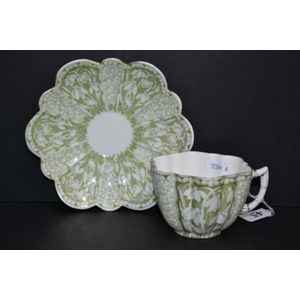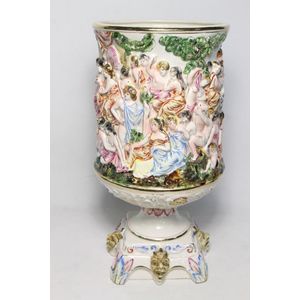Derby Frill Vase with Encrusted Flowers and Insects
You must be a subscriber, and be logged in to view price and dealer details.
Subscribe Now to view actual auction price for this item
When you subscribe, you have the option of setting the currency in which to display prices to $Au, $US, $NZ or Stg.
- Husk Motif - The husk motif is a decorative element that has been used in furniture, silver, glass and ceramics decoration for centuries. The motif is typically based on the shape of the husk, or outer covering, of a nut or seed. It is often depicted as a series of overlapping, scalloped shells that create a textured, ornamental pattern.
In furniture, the husk motif is commonly used in the design of chair and table legs, as well as in the decoration of cabinet doors and drawer fronts. The motif is carved into the wood or other material, creating a three-dimensional effect that adds depth and visual interest to the piece.
In ceramics, the husk motif is used in a variety of ways, from the decoration of bowls and plates to the design of decorative tiles and other objects. The motif is often painted or carved into the surface of the clay, creating a relief pattern that adds texture and dimensionality to the piece.
The husk motif has been used in many different historical and cultural contexts, from ancient Greece and Rome to 18th-century France and England. It has been adapted and modified over time, with variations including the acanthus leaf and the palmette motif. - Circa - A Latin term meaning 'about', often used in the antique trade to give an approximate date for the piece, usually considered to be five years on either side of the circa year. Thus, circa 1900 means the piece was made about 1900, probably between 1895 and 1905. The expression is sometimes abbreviated to c.1900.
- Cupid Motif - The Cupid motif, which features the Roman god of love and desire, Cupid, was a popular decorative element in classical ornamentation. Cupid was often depicted as a winged, naked baby with a bow and arrow, and was often used to symbolize love and desire.
In classical art and architecture, Cupid motifs were often used as decorative elements on furniture, such as on the legs of chairs and tables, as well as on architectural elements such as friezes and pediments. They were also used as decorative elements in frescoes, mosaics, and other forms of art.
During the Renaissance, Cupid motifs were often incorporated into the decoration of palaces, churches and other grand buildings, as they were seen as symbols of love and fertility. Cupid motifs were also commonly used in the decorative arts of the Baroque period, often appearing in the form of putti, which are small winged cherub figures.
In addition to their decorative use, Cupid motifs were also believed to hold symbolic meaning, as they were thought to evoke feelings of love, desire, and fertility.
This item has been included into following indexes:
Visually similar items

A reticulated frill vase in the manner of bow, circa 1760s, a conical vase with a flaring trellis rim with applied green florets, encrusted to the body with colourful flowers, twin masks and various moths and insects, a green frill to the lower section, wi

A Derby frilled polychrome pot pourri, circa 1765, in the rocaille manner with pierced and applied shell shapes and frills picked out in gilt, profusely encrusted with flowers to the body and domed lid, painted to one face with two birds in a branch, and w

Foley porcelain cup and saucer

A monumental Capodimonte ceramic wine cooler, with Italian hallmark, height 50 cm top dia. 25 cm
